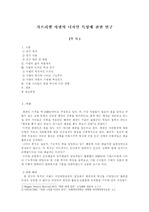

-
미리보기
서지정보
· 발행기관 : 한말연구학회
· 수록지 정보 : 한말연구 / 64권 / 55호 / 1 ~ 20페이지
· 저자명 : 고나경, 최대희
초록
This study aims to examine the frequency trends and morphosyntactic features of nominal compositions in magazines from the 1920s. To summarize, the contents are as follows.
In Chapter 2, examined the evolution of nominal composition and the frequency trends of nominal compositions in the 1920s. Initially, in the 15th century, '-(eu)m,' which derived from the preposed '-o/u-', was dominant. However, from the 16th century onward, '-o/u-' began to waver, and '-(eu)m' also started to decline. In this context, the frequency of the emergence of '-ki' increased. Subsequently, '-(eu)m' gradually decreased, while both '-ki' and '-ㄴ 것' showed an increasing trend. Nevertheless, until the 19th and early 20th centuries, '-(eu)m' remained dominant. Next, examined the frequency trends, which can be summarized into three main points. Firstly, there is a continuous decrease in the usage of '-(eu)m.' Secondly, there is a rise and maintenance in the usage of '-ki.' Thirdly, there is a consistent increase in the usage of '-ㄴ 것.' In summary, the frequency trends of nominal compositions in the magazines of the 1920s indicate that the usage of '-ki' and '-ㄴ 것,' which had been gradually increasing in previous periods, surpassed the frequency of '-(eu)m.' In Chapter 3, examined the morphological features of nominal composition. The three nominal compositions involve the combination of tense and honorific forms. First, looking at the combination of tense forms, '-(eu)m' and '-ki' combine in the real, perfect, and indeterminate forms, while '-ㄴ 것' appears only in the real form. Moving on to the honorific forms, '-(eu)m' and '-ㄴ 것' combine with subject honorifics, and '-ki' combines with both subject and relative honorifics.
In Chapter 4, the syntactic features of nominal composition were examined. All three nominal compositions functioned as subject, object, and adverbial phrases; however, examples of the '-ki' nominal composition functioning as a complement or predicate were not found.영어초록
This study aims to examine the frequency trends and morphosyntactic features of nominal compositions in magazines from the 1920s. To summarize, the contents are as follows.
In Chapter 2, examined the evolution of nominal composition and the frequency trends of nominal compositions in the 1920s. Initially, in the 15th century, '-(eu)m,' which derived from the preposed '-o/u-', was dominant. However, from the 16th century onward, '-o/u-' began to waver, and '-(eu)m' also started to decline. In this context, the frequency of the emergence of '-ki' increased. Subsequently, '-(eu)m' gradually decreased, while both '-ki' and '-ㄴ 것' showed an increasing trend. Nevertheless, until the 19th and early 20th centuries, '-(eu)m' remained dominant. Next, examined the frequency trends, which can be summarized into three main points. Firstly, there is a continuous decrease in the usage of '-(eu)m.' Secondly, there is a rise and maintenance in the usage of '-ki.' Thirdly, there is a consistent increase in the usage of '-ㄴ 것.' In summary, the frequency trends of nominal compositions in the magazines of the 1920s indicate that the usage of '-ki' and '-ㄴ 것,' which had been gradually increasing in previous periods, surpassed the frequency of '-(eu)m.' In Chapter 3, examined the morphological features of nominal composition. The three nominal compositions involve the combination of tense and honorific forms. First, looking at the combination of tense forms, '-(eu)m' and '-ki' combine in the real, perfect, and indeterminate forms, while '-ㄴ 것' appears only in the real form. Moving on to the honorific forms, '-(eu)m' and '-ㄴ 것' combine with subject honorifics, and '-ki' combines with both subject and relative honorifics.
In Chapter 4, the syntactic features of nominal composition were examined. All three nominal compositions functioned as subject, object, and adverbial phrases; however, examples of the '-ki' nominal composition functioning as a complement or predicate were not found.참고자료
· 없음태그
-
자주묻는질문의 답변을 확인해 주세요

꼭 알아주세요
-
자료의 정보 및 내용의 진실성에 대하여 해피캠퍼스는 보증하지 않으며, 해당 정보 및 게시물 저작권과 기타 법적 책임은 자료 등록자에게 있습니다.
자료 및 게시물 내용의 불법적 이용, 무단 전재∙배포는 금지되어 있습니다.
저작권침해, 명예훼손 등 분쟁 요소 발견 시 고객센터의 저작권침해 신고센터를 이용해 주시기 바랍니다. -
해피캠퍼스는 구매자와 판매자 모두가 만족하는 서비스가 되도록 노력하고 있으며, 아래의 4가지 자료환불 조건을 꼭 확인해주시기 바랍니다.
파일오류 중복자료 저작권 없음 설명과 실제 내용 불일치 파일의 다운로드가 제대로 되지 않거나 파일형식에 맞는 프로그램으로 정상 작동하지 않는 경우 다른 자료와 70% 이상 내용이 일치하는 경우 (중복임을 확인할 수 있는 근거 필요함) 인터넷의 다른 사이트, 연구기관, 학교, 서적 등의 자료를 도용한 경우 자료의 설명과 실제 자료의 내용이 일치하지 않는 경우
찾으시던 자료가 아닌가요?
지금 보는 자료와 연관되어 있어요!
문서 초안을 생성해주는 EasyAI




